Urinary Catheter Market
Urinary Catheter Market Size and Share Forecast Outlook 2025 to 2035
Urinary catheter market is projected to grow from USD 6.5 billion in 2025 to USD 12.0 billion by 2035, at a CAGR of 6.3%. Intermittent Catheter will dominate with a 57.9% market share, while coated catheter will lead the type segment with a 61.1% share.
Urinary Catheter Market Forecast and Outlook 2025 to 2035
The global urinary catheter market is projected to grow from USD 6.5 billion in 2025 to approximately USD 12.0 billion by 2035, recording an absolute increase of USD 5.5 billion over the forecast period. This translates into a total growth of 84.6%, with the market forecast to expand at a compound annual growth rate (CAGR) of 6.3% between 2025 and 2035.
The overall market size is expected to grow by nearly 1.8X during the same period, supported by increasing prevalence of urological disorders, rising adoption of antimicrobial-coated catheter technologies, and growing preference for home-based catheterization solutions across the global healthcare and medical device sectors.
Quick Stats for Urinary Catheter Market
- Urinary Catheter Market Value (2025): USD 6.5 billion
- Urinary Catheter Market Forecast Value (2035): USD 12.0 billion
- Urinary Catheter Market Forecast CAGR: 6.3%
- Leading Product in Urinary Catheter Market: Intermittent Catheter (57.9%)
- Key Growth Regions in Urinary Catheter Market: North America, Europe, and Asia Pacific
- Key Players in Urinary Catheter Market: BD (Becton, Dickinson & Co.), Coloplast Corp, B. Braun SE, Medline Industries LP, Hollister Incorporated, Teleflex Incorporated, Boston Scientific Corporation, Convatec Group Plc, Wellspect HealthCare (Dentsply Sirona), Cook Medical
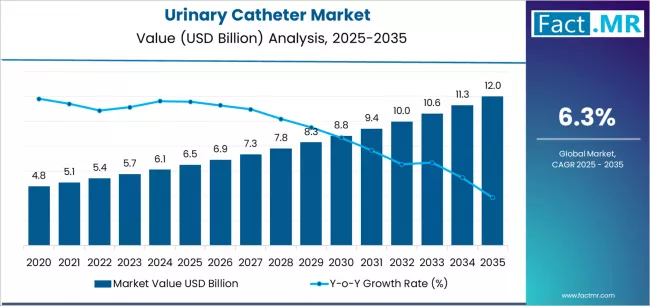
Between 2025 and 2030, the urinary catheter market is projected to expand from USD 6.5 billion to USD 8.9 billion, resulting in a value increase of USD 2.4 billion, which represents 43.6% of the total forecast growth for the decade. This phase of development will be shaped by rising demand for infection-control medical devices, increasing adoption of intermittent catheterization protocols, and growing penetration in home healthcare and long-term care segments. Medical device manufacturers are expanding their urinary catheter capabilities to address the growing need for patient-friendly and infection-resistant devices in various clinical applications and care settings.
From 2030 to 2035, the market is forecast to grow from USD 8.9 billion to USD 12.0 billion, adding another USD 3.1 billion, which constitutes 56.4% of the overall ten-year expansion. This period is expected to be characterized by the expansion of home healthcare infrastructure, the integration of innovative coating technologies, and the development of specialized catheter designs for specific patient populations. The growing recognition of catheter-associated infection prevention and patient self-management requirements will drive demand for ultra-high quality urinary catheter systems with enhanced safety specifications and consistent clinical outcomes.
Between 2020 and 2025, the urinary catheter market experienced steady expansion, driven by increasing recognition of infection control importance in urological care and growing acceptance of advanced catheter technologies in comprehensive patient management protocols. The market developed as healthcare providers recognized the need for safer catheterization options to address patient requirements and improve overall clinical outcomes. Research and development activities have emphasized the importance of advanced coating technologies in achieving better infection prevention and patient comfort in urological procedures.
Urinary Catheter Market Key Takeaways
| Metric | Value |
|---|---|
| Estimated Value in (2025E) | USD 6.5 billion |
| Forecast Value in (2035F) | USD 12.0 billion |
| Forecast CAGR (2025 to 2035) | 6.3% |
Why is the Urinary Catheter Market Growing?
Market expansion is being supported by the increasing prevalence of urological conditions and the corresponding need for effective catheterization solutions in patient care across global healthcare systems and home care operations. Modern healthcare providers are increasingly focused on infection-resistant urinary catheter that can improve patient safety, reduce complication rates, and enhance care quality while meeting stringent clinical requirements. The proven efficacy of advanced urinary catheter in various medical applications makes them an essential component of comprehensive urological care strategies and patient management programs.
The growing emphasis on infection prevention and patient-centered care optimization is driving demand for ultra-efficient urinary catheter that meet stringent safety specifications and clinical performance requirements for medical applications. Healthcare providers' preference for reliable, high-performance medical devices that can ensure consistent patient outcomes is creating opportunities for innovative catheter formulations and customized clinical solutions. The rising influence of infection control guidelines and patient safety protocols is also contributing to increased adoption of premium-grade urinary catheter across different healthcare applications and medical systems requiring advanced device technology.
Opportunity Pathways - Urinary Catheter Market
The urinary catheter market represents a specialized growth opportunity, expanding from USD 6.5 billion in 2025 to USD 12.0 billion by 2035 at a 6.3% CAGR. As healthcare providers prioritize infection prevention, patient comfort, and clinical efficacy in complex urological care processes, urinary catheter systems have evolved from a basic medical device to an essential component enabling bladder management, infection control optimization, and multi-setting patient care across healthcare operations and specialized urological applications.
The convergence of aging population expansion, increasing urological disorder prevalence, specialized home healthcare growth, and infection control requirements creates momentum in demand. High-quality products offering superior safety performance, cost-effective catheter systems balancing functionality with infection prevention, and specialized variants for critical applications will capture market premiums, while geographic expansion into high-growth Asian healthcare markets and emerging market penetration will drive volume leadership. Patient emphasis on safety quality and clinical reliability provides structural support.
Segmental Analysis
The market is segmented by product, type, end use, and region. By product, the market is divided into intermittent catheter, foley/indwelling catheter, and external catheter. Based on type, the market is categorized into coated catheter and uncoated catheter. By end use, the market is segmented into hospitals, long-term care facilities, and home healthcare. Regionally, the market is divided into North America, Europe, Asia Pacific, Latin America, and Middle East & Africa.
By Product, why are Intermittent Catheter Driving Market Leadership?
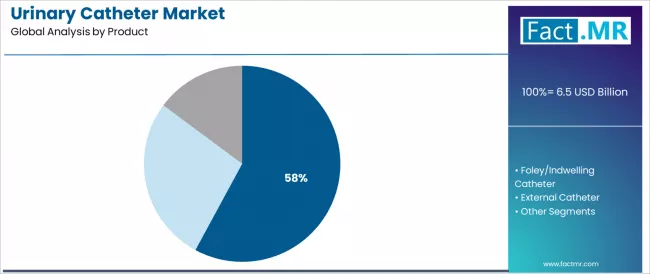
The intermittent catheter segment is projected to account for 57.9% of the urinary catheter market in 2025, reaffirming its position as the category's dominant product. Healthcare providers increasingly recognize the optimal balance of infection prevention and patient independence offered by intermittent catheter for most self-catheterization protocols, particularly in home care and outpatient settings. This product category addresses both clinical safety requirements and patient quality of life considerations while providing reliable bladder management performance across diverse patient populations.
This product forms the foundation of most catheterization protocols for chronic urinary retention management, as it represents the most clinically recommended and patient-preferred catheterization method in modern urology. Clinical evidence standards and extensive patient outcome data continue to strengthen confidence in intermittent catheterization among healthcare providers and patients. With increasing recognition of the infection prevention and bladder health optimization requirements in urological care, intermittent catheter systems align with both clinical best practices and patient autonomy goals, making them the central growth driver of comprehensive bladder management strategies.
By Type, Why Do Coated Catheter Command Majority Market Share?
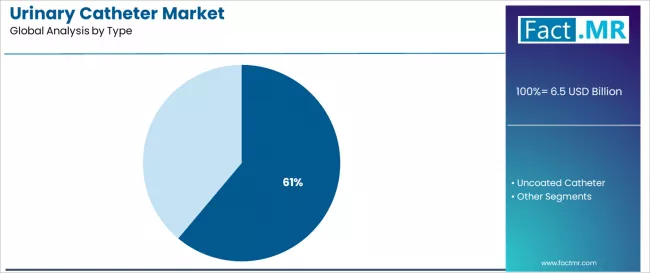
Coated catheter are projected to represent 61.1% of urinary catheter demand in 2025, underscoring their role as the primary catheter type segment driving market adoption and growth. Healthcare providers recognize that coated catheter requirements, including hydrophilic lubrication, antimicrobial properties, and reduced friction insertion, often provide clinical advantages that uncoated devices cannot adequately deliver. Coated catheter offer enhanced patient comfort and infection risk reduction in clinical catheterization applications.
The segment is supported by the growing nature of infection control protocol adoption, requiring sophisticated coating technologies, and the increasing recognition that coated catheter can improve patient compliance and reduce catheter-associated urinary tract infections. Additionally, healthcare providers are increasingly adopting evidence-based device selection guidelines that recommend specific coated catheter types for optimal patient outcomes. As understanding of catheter-related complications advances and safety requirements become more stringent, coated catheter will continue to play a crucial role in comprehensive urological care strategies within the medical device market.
By End Use, What Drives Hospitals' Market Dominance?
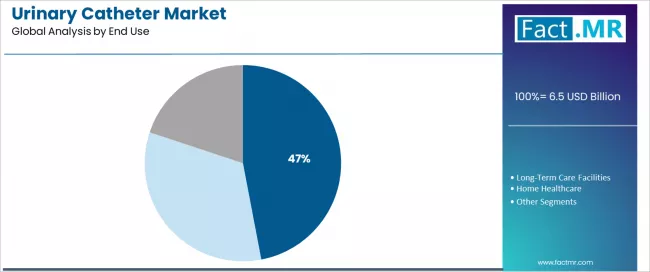
Hospitals are projected to account for 47.0% of the urinary catheter market in 2025, establishing their position as the dominant end use category. Healthcare administrators recognize the clinical necessity and procedural requirements offered by catheterization in most acute care and perioperative settings, particularly in surgical and intensive care operations. This end use segment addresses both immediate patient care requirements and clinical protocol considerations while providing reliable bladder management across diverse medical conditions.
The segment benefits from established hospital infrastructure and the growing recognition that proper catheterization protocols are essential for acute patient care and postoperative management. Clinical standard documentation and continuous quality monitoring capabilities continue to strengthen confidence in hospital catheterization practices among healthcare providers. With increasing demand for infection prevention protocols and standardized catheter care requirements, hospital catheter utilization systems align with both patient safety and clinical efficiency goals.
What are the Drivers, Restraints, and Key Trends of the Urinary Catheter Market?
The urinary catheter market is advancing steadily due to increasing recognition of infection prevention importance and growing demand for patient-friendly catheterization solutions across the healthcare sector. However, the market faces challenges, including concerns about catheter-associated urinary tract infections, potential for patient discomfort during catheterization procedures, and reimbursement limitations in certain healthcare markets. Innovation in coating technologies and catheter design continues to influence product development and market expansion patterns.
Expansion of Aging Population and Home Healthcare Technologies
The growing prevalence of age-related urological conditions is enabling the development of more sophisticated intermittent catheter applications and home-based care systems that can meet stringent patient independence requirements. Aging populations offer comprehensive demand for urinary catheter, including user-friendly and discrete formulations that are particularly important for achieving self-management in home healthcare applications. Advanced catheter technologies provide access to easy-insertion products that can optimize patient compliance and reduce healthcare utilization concerns while maintaining cost-effectiveness for healthcare system operations.
Integration of Antimicrobial Coatings and Infection Prevention Systems
Modern medical device organizations are incorporating advanced coating technologies such as hydrophilic surfaces, antimicrobial agents, and friction-reducing materials to enhance catheter safety and patient comfort. These innovations improve clinical outcomes, enable comprehensive infection prevention, and provide better patient experiences throughout the catheterization process. Advanced coating capabilities also enable specialized product offerings and early identification of emerging infection patterns or device complications, supporting reliable patient safety.
Analysis of the Urinary Catheter Market by Key Countries
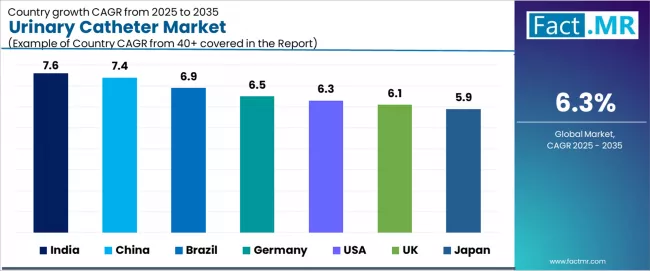
| Country | CAGR (2025-2035) |
|---|---|
| India | 7.6% |
| China | 7.4% |
| Brazil | 6.9% |
| Germany | 6.5% |
| USA | 6.3% |
| UK | 6.1% |
| Japan | 5.9% |
The urinary catheter market is experiencing varied growth globally, with India leading at a 7.6% CAGR through 2035, driven by expanding geriatric population and improving hospital access in tier-2 cities integrating catheter technologies into urological care programs. China follows at 7.4%, supported by aging demographics and increased awareness of home-based urinary management, along with growing healthcare infrastructure. Brazil records 6.9% growth, with expanding private healthcare and higher incidence of diabetes-related urological disorders.
The USA shows 6.3% growth, representing mature market expansion through home healthcare demand and increased use of antimicrobial-coated devices. Germany demonstrates 6.5% growth, emphasizing high hospital utilization and growth in coated catheter adoption. UK records 6.1% growth with rising adoption of intermittent and external catheter for self-use driven by home care initiatives, while Japan shows 5.9% growth, representing elderly-driven demand and strong clinical compliance with infection-control standards.
India Demonstrates Growing Market Potential with Geriatric Care Innovation
Revenue from urinary catheter in India is projected to exhibit robust growth with a CAGR of 7.6% through 2035, driven by ongoing geriatric population expansion and increasing recognition of urinary catheter as essential medical devices for urological condition management. The country's expanding hospital infrastructure and growing availability of specialized urological care capabilities are creating significant opportunities for urinary catheter adoption across both tier-1 metropolitan hospitals and emerging tier-2 city healthcare facilities. Major international and domestic medical device companies are establishing comprehensive distribution and supply networks to serve the growing population of patients requiring catheterization solutions across acute care and home healthcare applications throughout India's major urban and emerging medical centers.
The Indian government's strategic emphasis on healthcare infrastructure modernization and medical device manufacturing is driving substantial investments in specialized device supply capabilities. This policy support, combined with the country's large aging population and expanding healthcare access requirements, creates a favorable environment for urinary catheter market development. Indian healthcare providers are increasingly focusing on infection-prevention device technologies to improve patient outcomes, with coated catheter representing a key component in this clinical transformation.
- Government initiatives supporting healthcare infrastructure development and medical device manufacturing are driving demand for quality urinary catheter.
- Hospital capacity expansion and urology department development are supporting appropriate utilization of catheter technologies among providers and care facilities nationwide.
- Home healthcare service providers are increasingly offering catheterization training programs, creating accessible self-care options for chronic patients.
- Rising healthcare awareness and growing recognition of urological health management are accelerating catheter adoption across multiple patient segments.
China Demonstrates Exceptional Market Potential with Aging Population Growth
Revenue from urinary catheter in China is expanding at a CAGR of 7.4%, supported by increasing aging population prevalence, growing awareness of home-based urinary management, and developing healthcare infrastructure presence across the country's major urban and rural clusters. The country's large elderly population and increasing recognition of urological care needs are driving demand for effective catheterization solutions in both hospital and home healthcare applications. International medical device companies and domestic manufacturers are establishing comprehensive distribution channels to serve the growing demand for quality urinary catheter while supporting the country's position as an emerging urological care market.
China's healthcare sector continues to benefit from favorable medical device policies, expanding hospital capabilities, and government-supported elderly care programs. The country's focus on addressing aging population healthcare needs is driving investments in specialized medical device access and care infrastructure. This development is particularly important for urinary catheter applications, as healthcare providers seek reliable sources for critical urological devices to address care gaps and improve patient quality of life.
- Rising awareness about urological health management and improving home healthcare capabilities are creating opportunities for specialized catheter products.
- Growing hospital infrastructure development and urology department expansion are supporting increased access to quality catheterization devices among healthcare organizations.
- Aging demographics and increased prevalence of urinary retention conditions are driving steady demand for intermittent and indwelling catheter.
- National health insurance expansion is enabling broader patient access to catheterization solutions, supporting prescription and device utilization growth.
Brazil Maintains Urological Care Market Leadership
Revenue from urinary catheter in Brazil is projected to exhibit strong growth with a CAGR of 6.9% through 2035, driven by expanding private healthcare infrastructure and increasing prevalence of diabetes-related urological disorders. The country's developing hospital networks and growing medical device distribution expertise are creating significant opportunities for urinary catheter adoption across both public and private healthcare markets. Brazilian medical device distributors are leveraging their market access advantages to serve the growing demand for catheterization solutions while supporting the country's position as a regional urological care leader. The Brazilian market benefits from favorable healthcare expansion policies, growing private sector capabilities, and increasing awareness of urological health management. This development is particularly important for urinary catheter applications, as healthcare providers address growing patient populations with chronic conditions requiring catheterization support.
Strategic Market Considerations:
- Hospital and home healthcare segments leading growth with focus on infection prevention and patient safety applications
- Regional healthcare requirements are driving a diverse product portfolio from basic uncoated catheter to advanced antimicrobial platforms
- Private healthcare expansion supporting market growth in major metropolitan areas
- Government health initiatives influencing device quality standards and infection control requirements
USA Maintains Home Healthcare Leadership
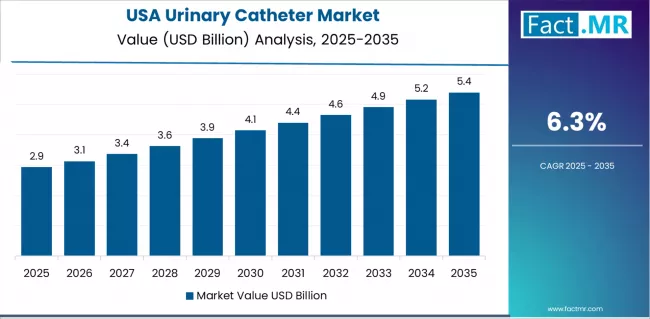
USA's advanced home healthcare infrastructure demonstrates sophisticated device deployment with documented urinary catheter effectiveness in chronic urinary retention and postoperative care applications through integration with existing patient care systems and insurance reimbursement infrastructure. The country leverages clinical expertise in catheterization protocols and infection prevention to maintain a 6.3% CAGR through 2035. Healthcare centers, including major hospital networks and home health agencies, showcase premium catheter protocols where urinary catheter systems integrate with comprehensive patient care platforms and infection monitoring systems to optimize safety outcomes and care compliance effectiveness.
American healthcare providers prioritize device safety and infection prevention in catheterization protocols, creating demand for premium urinary catheter with advanced features, including antimicrobial coatings and integration with US clinical guidelines. The market benefits from established home healthcare infrastructure and willingness to invest in advanced medical devices that provide long-term patient safety benefits and compliance with infection control protocols.
Strategic Market Considerations:
- Antimicrobial-coated and intermittent catheter segments leading growth with focus on infection prevention and home care optimization applications
- Regional care requirements are driving a diverse product portfolio from standard foley catheter to advanced hydrophilic platforms
- Insurance reimbursement partnerships with major payers supporting device accessibility
- Government infection control initiatives beginning to influence device selection standards and clinical requirements
Germany Shows Strong Regional Leadership
Germany's market expansion benefits from diverse urological care demand, including high hospital utilization in major medical centers, coated catheter adoption programs, and infection prevention initiatives that increasingly incorporate advanced catheter solutions for patient safety applications. The country maintains a 6.5% CAGR through 2035, driven by rising infection control awareness and increasing recognition of coated catheter benefits, including superior safety capabilities and reduced complication complexity.
Market dynamics focus on high-quality urinary catheter that balance advanced coating features with clinical evidence considerations important to German healthcare providers. Growing hospital and outpatient infrastructure creates demand for modern catheterization systems in new care facilities and patient safety innovation projects.
Strategic Market Considerations:
- Coated catheter and hospital segments leading growth with focus on infection prevention and clinical safety applications
- Regional care requirements are driving a diverse product portfolio from standard catheter to advanced antimicrobial platforms
- Healthcare system integration with infection surveillance networks supporting quality standards
- Government health initiatives beginning to influence device procurement standards and safety requirements
UK Demonstrates Home Care Excellence
UK's market expansion benefits from diverse catheterization demand, including NHS home healthcare expansion and intermittent catheter adoption growth. The country maintains a 6.1% CAGR through 2035, driven by rising self-catheterization adoption and increasing preference for patient-managed bladder care through specialized home care channels. The market prioritizes advanced device features, including ease-of-use design and integration with comprehensive care platforms that reflect UK healthcare expectations for patient independence and device quality.
British healthcare providers focus on patient-centered care innovation in catheterization protocols, creating demand for premium intermittent catheter with advanced features including insertion aids and comprehensive patient education support. The market benefits from established NHS home care infrastructure and investment in patient self-management technology that provides long-term quality of life benefits.
Strategic Market Considerations:
- Intermittent catheter and home healthcare segments leading growth with focus on patient independence and self-care optimization applications
- Regional care requirements are driving a diverse product portfolio from standard catheter to advanced user-friendly platforms
- NHS partnerships with medical device suppliers supporting home care program accessibility
- Government patient safety initiatives beginning to influence device standards and care protocol requirements
Japan Emphasizes Quality and Clinical Excellence
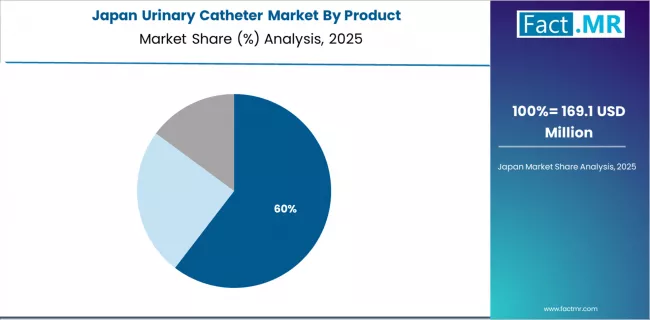
Japan demonstrates steady market development with a 5.9% CAGR through 2035, distinguished by healthcare providers' preference for high-quality urinary catheter that integrate seamlessly with existing infection control protocols and provide reliable clinical performance in elderly patient applications. The market prioritizes advanced features, including precision manufacturing standards, infection prevention validation, and integration with comprehensive geriatric care platforms that reflect Japanese healthcare expectations for device sophistication and clinical excellence.
Japanese healthcare providers focus on device reliability and infection control precision in catheterization protocols, creating demand for premium urinary catheter with advanced features including quality certification systems and comprehensive clinical support. The market benefits from established infection surveillance infrastructure and investment in elderly care technology that provides long-term patient safety benefits.
Strategic Market Indicators:
- Elderly care and infection prevention focus on precision devices with advanced safety profiles and high-reliability capabilities
- Integration requirements with existing hospital infection control systems and geriatric care platforms
- Emphasis on catheter safety and long-term infection prevention performance in elderly patient applications
Europe Market Split by Country
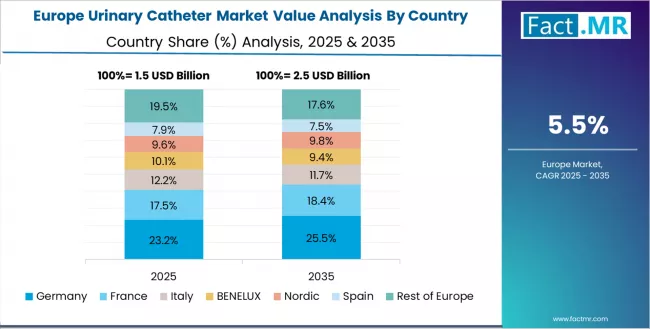
The urinary catheter market in Europe is projected to grow from USD 1.8 billion in 2025 to USD 3.3 billion by 2035, registering a CAGR of 6.3% over the forecast period. Germany is expected to maintain its leadership position with a 28.7% market share in 2025, rising to 29.4% by 2035, supported by its advanced hospital infrastructure, high coated catheter adoption capabilities, and strong infection control protocols throughout major healthcare regions.
France follows with a 22.9% share in 2025, projected to reach 23.5% by 2035, driven by comprehensive hospital catheterization protocols, innovative device adoption integration, and expanding urology service networks serving both public and private healthcare sectors. The UK holds a 20.3% share in 2025, expected to increase to 20.9% by 2035, supported by NHS home healthcare expansion and growing adoption of intermittent catheter programs. Italy commands a 15.6% share in 2025, projected to reach 15.9% by 2035, while Spain accounts for 9.2% in 2025, expected to reach 9.5% by 2035. The Rest of Europe region, including Nordic countries, Eastern Europe, and smaller Western European markets, is anticipated to hold 3.3% in 2025, declining to 0.8% by 2035, attributed to market consolidation toward larger core markets with established urological care and medical device distribution capabilities.
Competitive Landscape of the Urinary Catheter Market
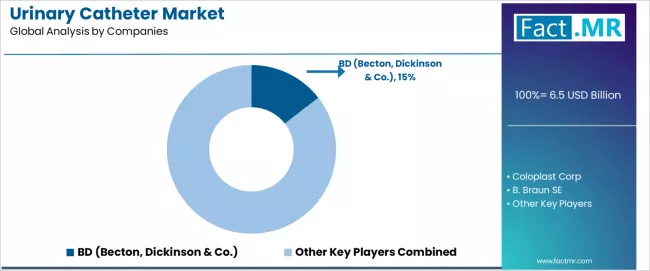
The urinary catheter market is characterized by competition among established medical device manufacturers, specialty urology companies, and infection control solution providers focused on delivering high-quality, safe, and clinically validated urinary catheterization products.
Companies are investing in coating technology advancement, clinical evidence development, strategic distribution partnerships, and healthcare provider education to deliver effective, reliable, and patient-friendly catheter solutions that meet stringent regulatory and clinical requirements. Product innovation, infection prevention validation protocols, and supply chain optimization strategies are central to strengthening product portfolios and market presence.
BD (Becton, Dickinson & Co.) leads the market with a 14.5% market share, offering comprehensive urinary catheter portfolios with a focus on infection prevention and clinical reliability for acute and chronic care applications. Coloplast Corp provides specialized intermittent catheter solutions with emphasis on patient-centered design and comprehensive self-care support services. B. Braun SE focuses on hospital-grade catheter systems and infection control technologies for clinical care serving international markets. Medline Industries LP delivers established catheter product lines with strong distribution systems and cost-competitive capabilities.
Hollister Incorporated operates with a focus on bringing innovative intermittent catheter technologies to specialized home healthcare applications and patient self-management markets. Teleflex Incorporated provides comprehensive catheter portfolios, including foley and specialty catheter, across multiple clinical applications and care settings. Boston Scientific Corporation specializes in advanced urological devices and catheter management systems for complex procedures with emphasis on clinical outcome optimization.
Convatec Group Plc provides patient-focused catheter products to enhance market accessibility and patient access to essential urological devices. Wellspect HealthCare (Dentsply Sirona) and Cook Medical focus on specialized catheter technologies and clinical innovation offerings for advanced urological care channels, emphasizing hydrophilic coating systems and direct healthcare provider engagement through evidence-based clinical support strategies.
Key Players in the Urinary Catheter Market
- BD (Becton, Dickinson & Co.)
- Coloplast Corp
- B. Braun SE
- Medline Industries LP
- Hollister Incorporated
- Teleflex Incorporated
- Boston Scientific Corporation
- Convatec Group Plc
- Wellspect HealthCare (Dentsply Sirona)
- Cook Medical
Scope of the Report
| Items | Values |
|---|---|
| Quantitative Value (USD Million)s (2025) | USD 6.5 Billion |
| Product | Intermittent Catheter, Foley/Indwelling Catheter, External Catheter |
| Type | Coated Catheter, Uncoated Catheter |
| End Use | Hospitals, Long-Term Care Facilities, Home Healthcare |
| Regions Covered | North America, Europe, Asia Pacific, Latin America, Middle East & Africa |
| Countries Covered | USA, Germany, UK, Japan, India, China, Brazil and 40+ countries |
| Key Companies Profiled | BD (Becton, Dickinson & Co.), Coloplast Corp, B. Braun SE, Medline Industries LP, Hollister Incorporated, Teleflex Incorporated, Boston Scientific Corporation, Convatec Group Plc, Wellspect HealthCare (Dentsply Sirona), and Cook Medical |
| Additional Attributes | Dollar sales by product type, catheter coating, and end use setting, regional utilization trends, competitive landscape, healthcare provider preferences for specific catheter technologies, integration with infection control protocols, innovations in coating technologies, clinical monitoring, and patient safety optimization |
Urinary Catheter Market by Segments
-
Product :
- Intermittent Catheter
- Foley/Indwelling Catheter
- External Catheter
-
Type :
- Coated Catheter
- Uncoated Catheter
-
End Use :
- Hospitals
- Long-Term Care Facilities
- Home Healthcare
-
Region :
-
North America
- USA
- Canada
- Mexico
-
Europe
- Germany
- France
- UK
- Italy
- Spain
- Nordic
- BENELUX
- Rest of Europe
-
Asia Pacific
- China
- India
- Japan
- South Korea
- ASEAN
- Australia & New Zealand
- Rest of Asia Pacific
-
Latin America
- Brazil
- Argentina
- Chile
- Rest of Latin America
-
Middle East & Africa
- Kingdom of Saudi Arabia
- Other GCC Countries
- Turkey
- South Africa
- Other African Countries
- Rest of Middle East & Africa
-
Table of Content
- Executive Summary
- Global Market Outlook
- Demand to side Trends
- Supply to side Trends
- Technology Roadmap Analysis
- Analysis and Recommendations
- Market Overview
- Market Coverage / Taxonomy
- Market Definition / Scope / Limitations
- Market Background
- Market Dynamics
- Drivers
- Restraints
- Opportunity
- Trends
- Scenario Forecast
- Demand in Optimistic Scenario
- Demand in Likely Scenario
- Demand in Conservative Scenario
- Opportunity Map Analysis
- Product Life Cycle Analysis
- Supply Chain Analysis
- Investment Feasibility Matrix
- Value Chain Analysis
- PESTLE and Porter’s Analysis
- Regulatory Landscape
- Regional Parent Market Outlook
- Production and Consumption Statistics
- Import and Export Statistics
- Market Dynamics
- Global Market Analysis 2020 to 2024 and Forecast, 2025 to 2035
- Historical Market Size Value (USD Million) Analysis, 2020 to 2024
- Current and Future Market Size Value (USD Million) Projections, 2025 to 2035
- Y to o to Y Growth Trend Analysis
- Absolute $ Opportunity Analysis
- Global Market Pricing Analysis 2020 to 2024 and Forecast 2025 to 2035
- Global Market Analysis 2020 to 2024 and Forecast 2025 to 2035, By Product
- Introduction / Key Findings
- Historical Market Size Value (USD Million) Analysis By Product, 2020 to 2024
- Current and Future Market Size Value (USD Million) Analysis and Forecast By Product, 2025 to 2035
- Intermittent Catheter
- Foley/Indwelling Catheter
- External Catheter
- Y to o to Y Growth Trend Analysis By Product, 2020 to 2024
- Absolute $ Opportunity Analysis By Product, 2025 to 2035
- Global Market Analysis 2020 to 2024 and Forecast 2025 to 2035, By Type
- Introduction / Key Findings
- Historical Market Size Value (USD Million) Analysis By Type, 2020 to 2024
- Current and Future Market Size Value (USD Million) Analysis and Forecast By Type, 2025 to 2035
- Coated Catheter
- Uncoated Catheter
- Y to o to Y Growth Trend Analysis By Type, 2020 to 2024
- Absolute $ Opportunity Analysis By Type, 2025 to 2035
- Global Market Analysis 2020 to 2024 and Forecast 2025 to 2035, By End Use
- Introduction / Key Findings
- Historical Market Size Value (USD Million) Analysis By End Use, 2020 to 2024
- Current and Future Market Size Value (USD Million) Analysis and Forecast By End Use, 2025 to 2035
- Hospitals
- Long-Term Care Facilities
- Home Healthcare
- Y to o to Y Growth Trend Analysis By End Use, 2020 to 2024
- Absolute $ Opportunity Analysis By End Use, 2025 to 2035
- Global Market Analysis 2020 to 2024 and Forecast 2025 to 2035, By Region
- Introduction
- Historical Market Size Value (USD Million) Analysis By Region, 2020 to 2024
- Current Market Size Value (USD Million) Analysis and Forecast By Region, 2025 to 2035
- North America
- Latin America
- Western Europe
- Eastern Europe
- East Asia
- South Asia and Pacific
- Middle East & Africa
- Market Attractiveness Analysis By Region
- North America Market Analysis 2020 to 2024 and Forecast 2025 to 2035, By Country
- Historical Market Size Value (USD Million) Trend Analysis By Market Taxonomy, 2020 to 2024
- Market Size Value (USD Million) Forecast By Market Taxonomy, 2025 to 2035
- By Country
- USA
- Canada
- Mexico
- By Product
- By Type
- By End Use
- By Country
- Market Attractiveness Analysis
- By Country
- By Product
- By Type
- By End Use
- Key Takeaways
- Latin America Market Analysis 2020 to 2024 and Forecast 2025 to 2035, By Country
- Historical Market Size Value (USD Million) Trend Analysis By Market Taxonomy, 2020 to 2024
- Market Size Value (USD Million) Forecast By Market Taxonomy, 2025 to 2035
- By Country
- Brazil
- Chile
- Rest of Latin America
- By Product
- By Type
- By End Use
- By Country
- Market Attractiveness Analysis
- By Country
- By Product
- By Type
- By End Use
- Key Takeaways
- Western Europe Market Analysis 2020 to 2024 and Forecast 2025 to 2035, By Country
- Historical Market Size Value (USD Million) Trend Analysis By Market Taxonomy, 2020 to 2024
- Market Size Value (USD Million) Forecast By Market Taxonomy, 2025 to 2035
- By Country
- Germany
- UK
- Italy
- Spain
- France
- Nordic
- BENELUX
- Rest of Western Europe
- By Product
- By Type
- By End Use
- By Country
- Market Attractiveness Analysis
- By Country
- By Product
- By Type
- By End Use
- Key Takeaways
- Eastern Europe Market Analysis 2020 to 2024 and Forecast 2025 to 2035, By Country
- Historical Market Size Value (USD Million) Trend Analysis By Market Taxonomy, 2020 to 2024
- Market Size Value (USD Million) Forecast By Market Taxonomy, 2025 to 2035
- By Country
- Russia
- Poland
- Hungary
- Balkan & Baltic
- Rest of Eastern Europe
- By Product
- By Type
- By End Use
- By Country
- Market Attractiveness Analysis
- By Country
- By Product
- By Type
- By End Use
- Key Takeaways
- East Asia Market Analysis 2020 to 2024 and Forecast 2025 to 2035, By Country
- Historical Market Size Value (USD Million) Trend Analysis By Market Taxonomy, 2020 to 2024
- Market Size Value (USD Million) Forecast By Market Taxonomy, 2025 to 2035
- By Country
- China
- Japan
- South Korea
- By Product
- By Type
- By End Use
- By Country
- Market Attractiveness Analysis
- By Country
- By Product
- By Type
- By End Use
- Key Takeaways
- South Asia and Pacific Market Analysis 2020 to 2024 and Forecast 2025 to 2035, By Country
- Historical Market Size Value (USD Million) Trend Analysis By Market Taxonomy, 2020 to 2024
- Market Size Value (USD Million) Forecast By Market Taxonomy, 2025 to 2035
- By Country
- India
- ASEAN
- Australia & New Zealand
- Rest of South Asia and Pacific
- By Product
- By Type
- By End Use
- By Country
- Market Attractiveness Analysis
- By Country
- By Product
- By Type
- By End Use
- Key Takeaways
- Middle East & Africa Market Analysis 2020 to 2024 and Forecast 2025 to 2035, By Country
- Historical Market Size Value (USD Million) Trend Analysis By Market Taxonomy, 2020 to 2024
- Market Size Value (USD Million) Forecast By Market Taxonomy, 2025 to 2035
- By Country
- Kingdom of Saudi Arabia
- Other GCC Countries
- Turkiye
- South Africa
- Other African Union
- Rest of Middle East & Africa
- By Product
- By Type
- By End Use
- By Country
- Market Attractiveness Analysis
- By Country
- By Product
- By Type
- By End Use
- Key Takeaways
- Key Countries Market Analysis
- USA
- Pricing Analysis
- Market Share Analysis, 2024
- By Product
- By Type
- By End Use
- Canada
- Pricing Analysis
- Market Share Analysis, 2024
- By Product
- By Type
- By End Use
- Mexico
- Pricing Analysis
- Market Share Analysis, 2024
- By Product
- By Type
- By End Use
- Brazil
- Pricing Analysis
- Market Share Analysis, 2024
- By Product
- By Type
- By End Use
- Chile
- Pricing Analysis
- Market Share Analysis, 2024
- By Product
- By Type
- By End Use
- Germany
- Pricing Analysis
- Market Share Analysis, 2024
- By Product
- By Type
- By End Use
- UK
- Pricing Analysis
- Market Share Analysis, 2024
- By Product
- By Type
- By End Use
- Italy
- Pricing Analysis
- Market Share Analysis, 2024
- By Product
- By Type
- By End Use
- Spain
- Pricing Analysis
- Market Share Analysis, 2024
- By Product
- By Type
- By End Use
- France
- Pricing Analysis
- Market Share Analysis, 2024
- By Product
- By Type
- By End Use
- India
- Pricing Analysis
- Market Share Analysis, 2024
- By Product
- By Type
- By End Use
- ASEAN
- Pricing Analysis
- Market Share Analysis, 2024
- By Product
- By Type
- By End Use
- Australia & New Zealand
- Pricing Analysis
- Market Share Analysis, 2024
- By Product
- By Type
- By End Use
- China
- Pricing Analysis
- Market Share Analysis, 2024
- By Product
- By Type
- By End Use
- Japan
- Pricing Analysis
- Market Share Analysis, 2024
- By Product
- By Type
- By End Use
- South Korea
- Pricing Analysis
- Market Share Analysis, 2024
- By Product
- By Type
- By End Use
- Russia
- Pricing Analysis
- Market Share Analysis, 2024
- By Product
- By Type
- By End Use
- Poland
- Pricing Analysis
- Market Share Analysis, 2024
- By Product
- By Type
- By End Use
- Hungary
- Pricing Analysis
- Market Share Analysis, 2024
- By Product
- By Type
- By End Use
- Kingdom of Saudi Arabia
- Pricing Analysis
- Market Share Analysis, 2024
- By Product
- By Type
- By End Use
- Turkiye
- Pricing Analysis
- Market Share Analysis, 2024
- By Product
- By Type
- By End Use
- South Africa
- Pricing Analysis
- Market Share Analysis, 2024
- By Product
- By Type
- By End Use
- USA
- Market Structure Analysis
- Competition Dashboard
- Competition Benchmarking
- Market Share Analysis of Top Players
- By Regional
- By Product
- By Type
- By End Use
- Competition Analysis
- Competition Deep Dive
- BD (Becton, Dickinson & Co.)
- Overview
- Product Portfolio
- Profitability by Market Segments (Product/Age /Sales Channel/Region)
- Sales Footprint
- Strategy Overview
- Marketing Strategy
- Product Strategy
- Channel Strategy
- Coloplast Corp
- B. Braun SE
- Medline Industries LP
- Hollister Incorporated
- Teleflex Incorporated
- Boston Scientific Corporation
- Convatec Group Plc
- Wellspect HealthCare (Dentsply Sirona)
- Cook Medical
- BD (Becton, Dickinson & Co.)
- Competition Deep Dive
- Assumptions & Acronyms Used
- Research Methodology
List Of Table
- Table 1: Global Market Value (USD Million) Forecast by Region, 2020 to 2035
- Table 2: Global Market Value (USD Million) Forecast by Product, 2020 to 2035
- Table 3: Global Market Value (USD Million) Forecast by Type, 2020 to 2035
- Table 4: Global Market Value (USD Million) Forecast by End Use, 2020 to 2035
- Table 5: North America Market Value (USD Million) Forecast by Country, 2020 to 2035
- Table 6: North America Market Value (USD Million) Forecast by Product, 2020 to 2035
- Table 7: North America Market Value (USD Million) Forecast by Type, 2020 to 2035
- Table 8: North America Market Value (USD Million) Forecast by End Use, 2020 to 2035
- Table 9: Latin America Market Value (USD Million) Forecast by Country, 2020 to 2035
- Table 10: Latin America Market Value (USD Million) Forecast by Product, 2020 to 2035
- Table 11: Latin America Market Value (USD Million) Forecast by Type, 2020 to 2035
- Table 12: Latin America Market Value (USD Million) Forecast by End Use, 2020 to 2035
- Table 13: Western Europe Market Value (USD Million) Forecast by Country, 2020 to 2035
- Table 14: Western Europe Market Value (USD Million) Forecast by Product, 2020 to 2035
- Table 15: Western Europe Market Value (USD Million) Forecast by Type, 2020 to 2035
- Table 16: Western Europe Market Value (USD Million) Forecast by End Use, 2020 to 2035
- Table 17: Eastern Europe Market Value (USD Million) Forecast by Country, 2020 to 2035
- Table 18: Eastern Europe Market Value (USD Million) Forecast by Product, 2020 to 2035
- Table 19: Eastern Europe Market Value (USD Million) Forecast by Type, 2020 to 2035
- Table 20: Eastern Europe Market Value (USD Million) Forecast by End Use, 2020 to 2035
- Table 21: East Asia Market Value (USD Million) Forecast by Country, 2020 to 2035
- Table 22: East Asia Market Value (USD Million) Forecast by Product, 2020 to 2035
- Table 23: East Asia Market Value (USD Million) Forecast by Type, 2020 to 2035
- Table 24: East Asia Market Value (USD Million) Forecast by End Use, 2020 to 2035
- Table 25: South Asia and Pacific Market Value (USD Million) Forecast by Country, 2020 to 2035
- Table 26: South Asia and Pacific Market Value (USD Million) Forecast by Product, 2020 to 2035
- Table 27: South Asia and Pacific Market Value (USD Million) Forecast by Type, 2020 to 2035
- Table 28: South Asia and Pacific Market Value (USD Million) Forecast by End Use, 2020 to 2035
- Table 29: Middle East & Africa Market Value (USD Million) Forecast by Country, 2020 to 2035
- Table 30: Middle East & Africa Market Value (USD Million) Forecast by Product, 2020 to 2035
- Table 31: Middle East & Africa Market Value (USD Million) Forecast by Type, 2020 to 2035
- Table 32: Middle East & Africa Market Value (USD Million) Forecast by End Use, 2020 to 2035
List Of Figures
- Figure 1: Global Market Pricing Analysis
- Figure 2: Global Market Value (USD Million) Forecast 2020 to 2035
- Figure 3: Global Market Value Share and BPS Analysis by Product, 2025 and 2035
- Figure 4: Global Market Y to o to Y Growth Comparison by Product, 2025 to 2035
- Figure 5: Global Market Attractiveness Analysis by Product
- Figure 6: Global Market Value Share and BPS Analysis by Type, 2025 and 2035
- Figure 7: Global Market Y to o to Y Growth Comparison by Type, 2025 to 2035
- Figure 8: Global Market Attractiveness Analysis by Type
- Figure 9: Global Market Value Share and BPS Analysis by End Use, 2025 and 2035
- Figure 10: Global Market Y to o to Y Growth Comparison by End Use, 2025 to 2035
- Figure 11: Global Market Attractiveness Analysis by End Use
- Figure 12: Global Market Value (USD Million) Share and BPS Analysis by Region, 2025 and 2035
- Figure 13: Global Market Y to o to Y Growth Comparison by Region, 2025 to 2035
- Figure 14: Global Market Attractiveness Analysis by Region
- Figure 15: North America Market Incremental Dollar Opportunity, 2025 to 2035
- Figure 16: Latin America Market Incremental Dollar Opportunity, 2025 to 2035
- Figure 17: Western Europe Market Incremental Dollar Opportunity, 2025 to 2035
- Figure 18: Eastern Europe Market Incremental Dollar Opportunity, 2025 to 2035
- Figure 19: East Asia Market Incremental Dollar Opportunity, 2025 to 2035
- Figure 20: South Asia and Pacific Market Incremental Dollar Opportunity, 2025 to 2035
- Figure 21: Middle East & Africa Market Incremental Dollar Opportunity, 2025 to 2035
- Figure 22: North America Market Value Share and BPS Analysis by Country, 2025 and 2035
- Figure 23: North America Market Value Share and BPS Analysis by Product, 2025 and 2035
- Figure 24: North America Market Y to o to Y Growth Comparison by Product, 2025 to 2035
- Figure 25: North America Market Attractiveness Analysis by Product
- Figure 26: North America Market Value Share and BPS Analysis by Type, 2025 and 2035
- Figure 27: North America Market Y to o to Y Growth Comparison by Type, 2025 to 2035
- Figure 28: North America Market Attractiveness Analysis by Type
- Figure 29: North America Market Value Share and BPS Analysis by End Use, 2025 and 2035
- Figure 30: North America Market Y to o to Y Growth Comparison by End Use, 2025 to 2035
- Figure 31: North America Market Attractiveness Analysis by End Use
- Figure 32: Latin America Market Value Share and BPS Analysis by Country, 2025 and 2035
- Figure 33: Latin America Market Value Share and BPS Analysis by Product, 2025 and 2035
- Figure 34: Latin America Market Y to o to Y Growth Comparison by Product, 2025 to 2035
- Figure 35: Latin America Market Attractiveness Analysis by Product
- Figure 36: Latin America Market Value Share and BPS Analysis by Type, 2025 and 2035
- Figure 37: Latin America Market Y to o to Y Growth Comparison by Type, 2025 to 2035
- Figure 38: Latin America Market Attractiveness Analysis by Type
- Figure 39: Latin America Market Value Share and BPS Analysis by End Use, 2025 and 2035
- Figure 40: Latin America Market Y to o to Y Growth Comparison by End Use, 2025 to 2035
- Figure 41: Latin America Market Attractiveness Analysis by End Use
- Figure 42: Western Europe Market Value Share and BPS Analysis by Country, 2025 and 2035
- Figure 43: Western Europe Market Value Share and BPS Analysis by Product, 2025 and 2035
- Figure 44: Western Europe Market Y to o to Y Growth Comparison by Product, 2025 to 2035
- Figure 45: Western Europe Market Attractiveness Analysis by Product
- Figure 46: Western Europe Market Value Share and BPS Analysis by Type, 2025 and 2035
- Figure 47: Western Europe Market Y to o to Y Growth Comparison by Type, 2025 to 2035
- Figure 48: Western Europe Market Attractiveness Analysis by Type
- Figure 49: Western Europe Market Value Share and BPS Analysis by End Use, 2025 and 2035
- Figure 50: Western Europe Market Y to o to Y Growth Comparison by End Use, 2025 to 2035
- Figure 51: Western Europe Market Attractiveness Analysis by End Use
- Figure 52: Eastern Europe Market Value Share and BPS Analysis by Country, 2025 and 2035
- Figure 53: Eastern Europe Market Value Share and BPS Analysis by Product, 2025 and 2035
- Figure 54: Eastern Europe Market Y to o to Y Growth Comparison by Product, 2025 to 2035
- Figure 55: Eastern Europe Market Attractiveness Analysis by Product
- Figure 56: Eastern Europe Market Value Share and BPS Analysis by Type, 2025 and 2035
- Figure 57: Eastern Europe Market Y to o to Y Growth Comparison by Type, 2025 to 2035
- Figure 58: Eastern Europe Market Attractiveness Analysis by Type
- Figure 59: Eastern Europe Market Value Share and BPS Analysis by End Use, 2025 and 2035
- Figure 60: Eastern Europe Market Y to o to Y Growth Comparison by End Use, 2025 to 2035
- Figure 61: Eastern Europe Market Attractiveness Analysis by End Use
- Figure 62: East Asia Market Value Share and BPS Analysis by Country, 2025 and 2035
- Figure 63: East Asia Market Value Share and BPS Analysis by Product, 2025 and 2035
- Figure 64: East Asia Market Y to o to Y Growth Comparison by Product, 2025 to 2035
- Figure 65: East Asia Market Attractiveness Analysis by Product
- Figure 66: East Asia Market Value Share and BPS Analysis by Type, 2025 and 2035
- Figure 67: East Asia Market Y to o to Y Growth Comparison by Type, 2025 to 2035
- Figure 68: East Asia Market Attractiveness Analysis by Type
- Figure 69: East Asia Market Value Share and BPS Analysis by End Use, 2025 and 2035
- Figure 70: East Asia Market Y to o to Y Growth Comparison by End Use, 2025 to 2035
- Figure 71: East Asia Market Attractiveness Analysis by End Use
- Figure 72: South Asia and Pacific Market Value Share and BPS Analysis by Country, 2025 and 2035
- Figure 73: South Asia and Pacific Market Value Share and BPS Analysis by Product, 2025 and 2035
- Figure 74: South Asia and Pacific Market Y to o to Y Growth Comparison by Product, 2025 to 2035
- Figure 75: South Asia and Pacific Market Attractiveness Analysis by Product
- Figure 76: South Asia and Pacific Market Value Share and BPS Analysis by Type, 2025 and 2035
- Figure 77: South Asia and Pacific Market Y to o to Y Growth Comparison by Type, 2025 to 2035
- Figure 78: South Asia and Pacific Market Attractiveness Analysis by Type
- Figure 79: South Asia and Pacific Market Value Share and BPS Analysis by End Use, 2025 and 2035
- Figure 80: South Asia and Pacific Market Y to o to Y Growth Comparison by End Use, 2025 to 2035
- Figure 81: South Asia and Pacific Market Attractiveness Analysis by End Use
- Figure 82: Middle East & Africa Market Value Share and BPS Analysis by Country, 2025 and 2035
- Figure 83: Middle East & Africa Market Value Share and BPS Analysis by Product, 2025 and 2035
- Figure 84: Middle East & Africa Market Y to o to Y Growth Comparison by Product, 2025 to 2035
- Figure 85: Middle East & Africa Market Attractiveness Analysis by Product
- Figure 86: Middle East & Africa Market Value Share and BPS Analysis by Type, 2025 and 2035
- Figure 87: Middle East & Africa Market Y to o to Y Growth Comparison by Type, 2025 to 2035
- Figure 88: Middle East & Africa Market Attractiveness Analysis by Type
- Figure 89: Middle East & Africa Market Value Share and BPS Analysis by End Use, 2025 and 2035
- Figure 90: Middle East & Africa Market Y to o to Y Growth Comparison by End Use, 2025 to 2035
- Figure 91: Middle East & Africa Market Attractiveness Analysis by End Use
- Figure 92: Global Market - Tier Structure Analysis
- Figure 93: Global Market - Company Share Analysis
- FAQs -
How big is the urinary catheter market in 2025?
The global urinary catheter market is estimated to be valued at USD 6.5 billion in 2025.
What will be the size of urinary catheter market in 2035?
The market size for the urinary catheter market is projected to reach USD 12.0 billion by 2035.
How much will be the urinary catheter market growth between 2025 and 2035?
The urinary catheter market is expected to grow at a 6.3% CAGR between 2025 and 2035.
What are the key product types in the urinary catheter market?
The key product types in urinary catheter market are intermittent catheter, foley/indwelling catheter and external catheter.
Which type segment to contribute significant share in the urinary catheter market in 2025?
In terms of type, coated catheter segment to command 61.1% share in the urinary catheter market in 2025.